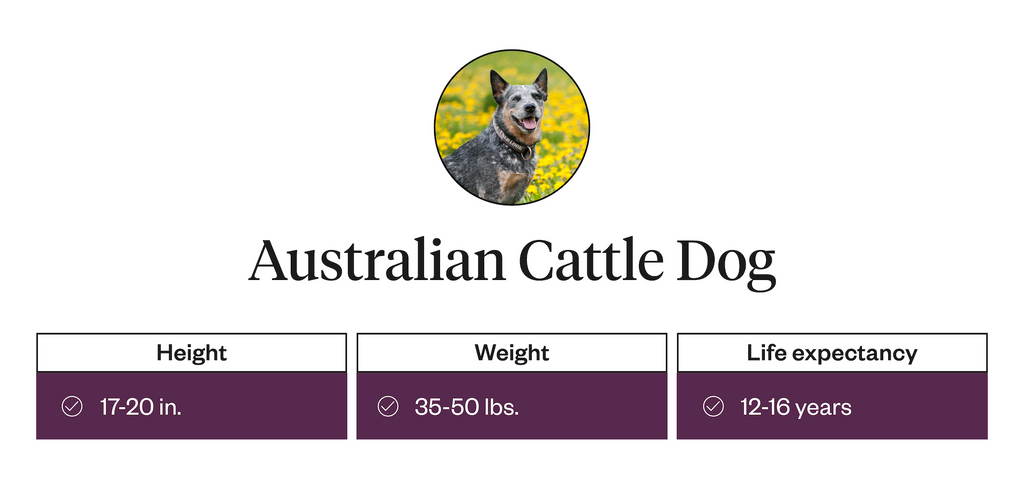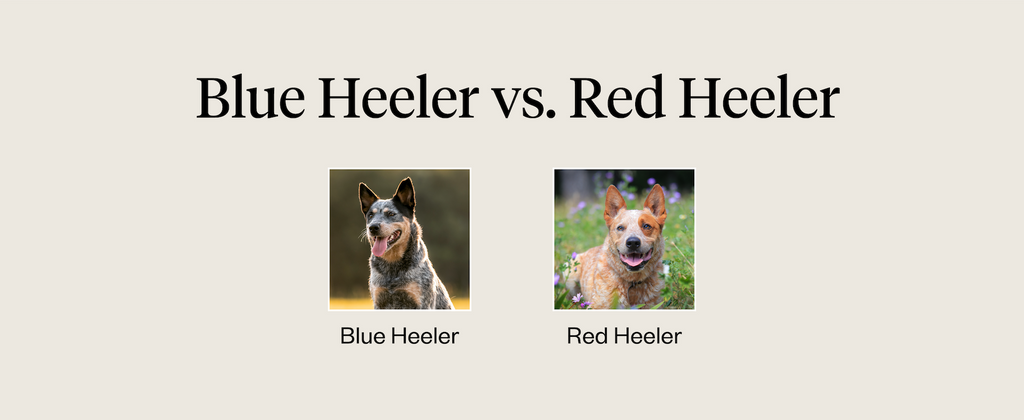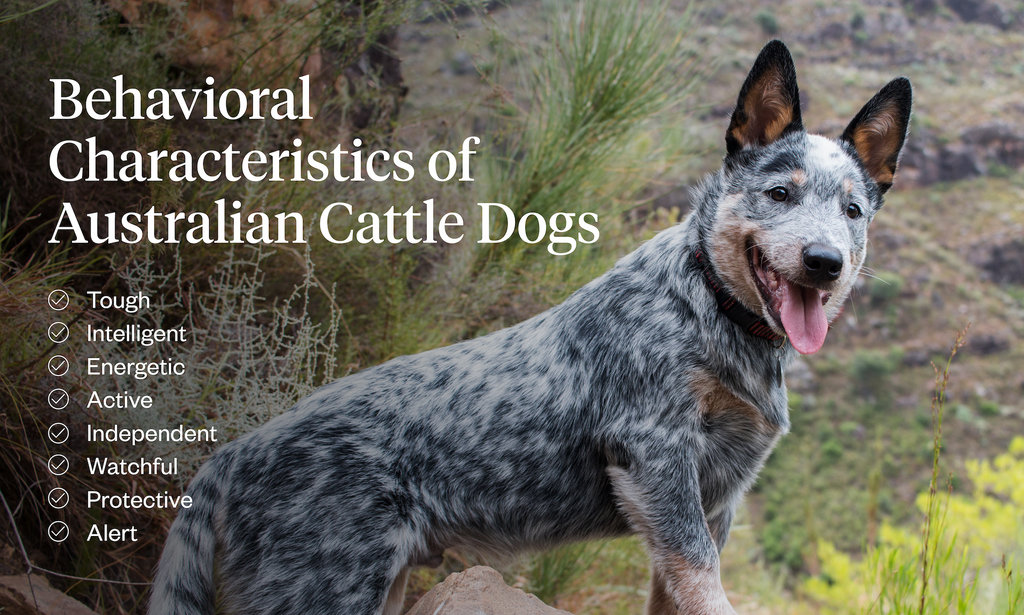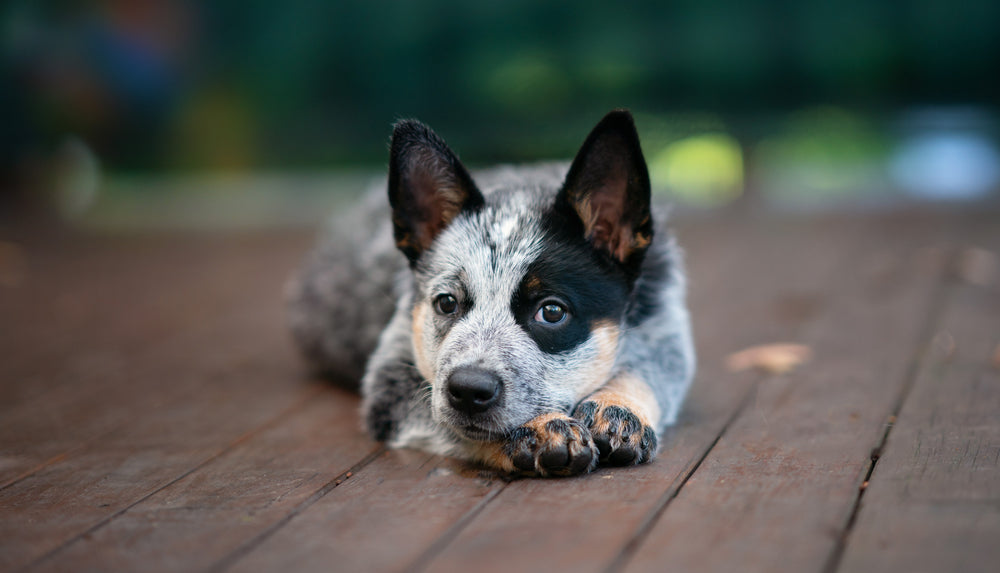8 Min Read
Australian Cattle Dog: Pet Profile
Key takeaway

Why pet owners are switching to online vet care with Dutch
-
Prescriptions delivered free to you
-
Fast access to Licensed Vets over video
-
Unlimited video visits and follow-ups
From the rugged terrains of Australia, the Australian Cattle Dog (ACD), recognized by its striking blue or red merle coat, is a resilient and intelligent breed with an unparalleled work ethic. Also known as Blue or Red Heelers or simply cattle dogs, the Australian Cattle Dog was bred to herd cattle.
This breed played a pivotal role in the livestock industry, but many have transitioned from outback pastures to become household pets. With their boundless energy, intelligence, and loyalty, Australian Cattle Dogs often fit perfectly into an active family's lifestyle.
Keep reading to learn more about this energetic, intelligent, and loyal breed.
- History & Origin of Australian Cattle Dogs
- Physical Attributes of Australian Cattle Dogs
- Behavioral Characteristics of Australian Cattle Dogs
- Australian Cattle Dog Health Risks
- Caring For an Australian Cattle Dog
- FAQs
- Final Notes
History & Origin of Australian Cattle Dogs
Australian Cattle Dogs were developed in the 19th century to herd cattle in the Australian outback.1 In the 1800s, a man in Queensland named George Elliot was experimenting with Collie crosses, which produced excellent herding dogs.2 From there, two brothers purchased some of Elliot's dogs and began improving them by breeding them with other dogs, such as the Dalmatian, producing red and blue coats.
The blue dogs became more popular and were called Blue Heelers because of their coloring and herding style. When moving livestock, the dogs nip at the heels of cattle to encourage them to move forward.
Today, many Australian Cattle Dogs maintain their breeding purpose and are celebrated as excellent herding dogs. However, they're also loyal companions, participate in various sporting events, and dog shows.

Physical Attributes of Australian Cattle Dogs
- Height: 17-20 in.
- Weight: 35-50 lbs.
- Lifespan: 12-16 years2
The Australian Cattle Dog was created to be robust and compact, designed for the agility and endurance necessary for herding cattle. One of the breed's most defining characteristics is its coat. Australian Cattle Dogs have a dual-layer coat with the outer layer short and straight and a dense undercoat that offers insulation.3
The two dominant shades of the Australian Cattle Dogs' coats are blue and red. The blue may be speckled with black, blue, or tan markings. On the other hand, the red is speckled with red throughout.3
Australian Cattle Dogs have a broad head and rectangular-shaped muzzle with pointed and erect ears. These dogs have strong bodies with thick necks and deep, muscular chests.
Another intriguing feature of the Australian Cattle Dog is the potential for a unique genetic trait where one eye is a different color from the other, also known as heterochromia.
 Australian Cattle Dogs vs. Red & Blue Heelers
Australian Cattle Dogs vs. Red & Blue Heelers
There's no difference between an Australian Cattle Dog vs. Blue Heeler. As mentioned, there are two varieties of Australian Cattle Dogs — Red and Blue Heelers. These dogs weren't bred for appearance; they were bred to work. Blue and red coat colors were produced by breeding various cattle dogs with other breeds. The Australian Cattle Dog Blue Heeler has blue speckled coats. On the other hand, the red Australian Cattle dog has a red speckled coat because their coat has a reddish appearance.
Therefore, there's no distinction between Australian Cattle Dogs vs. Blue or Red Heelers since they're all the same breed, just with different coat colors.

Behavioral Characteristics of Australian Cattle Dogs
The Australian Cattle Dog's temperament varies by individual pet. Generally, they're tough and bred to withstand the harsh Australian outback while herding cattle over vast, rough terrain.
They're bred to be resilient with a strong work ethic. As such, they're highly intelligent, a necessary trait for herding.3 They also excel at obedience, agility, and tricks.
Because they're a working breed, Australian Cattle Dogs are highly energetic and active. Remember, they were bred for driving cattle long distances, so they have boundless energy and require both mental and physical stimulation.3 Because Cattle Dogs were bred to cross vast terrains, they're less adaptable than other pets. They'll prefer homes with fenced yards where they can run and play.
In addition, while these dogs are loyal, they also tend to be independent. They're often happy to work with their human companions but also confident enough to make decisions independently, which is why they've made such good working dogs. However, they're often not overly affectionate with their family because of this.3
Herding cattle isn't easy, and these Cattle Dogs are watchful, making them excellent watchdogs.3 They typically have an overall warm nature, but they're protective because their main job was to herd and protect their livestock. They're also often protective of their human families.3
Keep in mind that every dog is different. Your Australian Cattle Dog's temperament will depend on various factors, including its individual personality, upbringing, training, and past experiences. While breed characteristics can provide you with general information, always remember that every dog is unique. Spending time with a potential pet before bringing it home can help you assess its personality and behavioral characteristics to determine if it's the right dog for you and your family.
Australian Cattle Dog Health Risks
Generally robust and hardy for working in the Australian outback, Cattle Dogs, like all breeds, are prone to certain health conditions. These include the following:
- Progressive Retinal Atrophy (PRA): Australian Cattle Dogs are prone to PRA, a hereditary condition that leads to the gradual deterioration of the retina.4
- Primary Lens Luxation (PLL): PLL is another hereditary eye condition that causes the spontaneous dislocation or displacement of the lens in the eye.4
- Hip dysplasia: Hip dysplasia is another heritable condition in which the thigh bone doesn't fit into the hip joint correctly. It can lead to lameness in the dog's hind legs and eventually lead to arthritis.4
- Elbow dysplasia: Elbow dysplasia is another hereditary condition in which the elbow joint develops abnormally and can lead to pain, lameness, and reduced mobility.4
- Dermatitis: One of the most common skin issues in dogs is dermatitis, which causes inflammation and itchiness. It can be triggered by allergies, parasites, or underlying illnesses.
- Urolithiasis: Urolithiasis is a condition in which storms form within the urinary system,[4] affecting urinary health and causing discomfort, blockages, and possible infections.
- Luxating patellas: Luxating patellas are a condition in which the patella — or kneecap – dislocates from the normal position in the thigh bone and can lead to discomfort, limping, or severe mobility issues.4
Caring For an Australian Cattle Dog
Australian Cattle Dogs are generally healthy. They're bred to be robust and sturdy. However, taking proper care of them is necessary to ensure optimal health.
Preventive care
Regular veterinary visits, also known as wellness exams, are essential for the early detection of health issues like hip dysplasia, PRA, and other hereditary conditions. Your ACD should be up to date on vaccinations, deworming, flea and tick preventives, and so forth.
Grooming needs
Australian Cattle Dogs have short, weather-resistant coats that require minimal grooming. A weekly brushing will help remove loose hair and facilitate shedding. Occasional baths every few months or as needed should be enough to keep them clean.
In addition, their nails should be trimmed regularly. You should also check your dog's ears for signs of infection and clean them every so often.
Exercise
Australian Cattle Dogs are very active and have high energy levels.3 As such, they need more than a quick walk around the block. They generally prefer a job to keep them happy, such as when working on a farm. However, in other living situations, other types of physical activity can suffice. For instance, a daily run or long walk and ample playtime in the yard or inside can satisfy your dog's exercise requirements.
You can also engage them in agility, herding, and hiking to channel their energy productively. Without enough exercise, these dogs can get bored and may be prone to destructive behaviors, so they're best suited for active families or individuals.
In addition to physical exercise, Australian Cattle Dogs require mental stimulation. Puzzles and tasks that challenge them, such as training, can be highly beneficial, especially for Australian Cattle Dog puppies.
FAQs
Are Australian Cattle Dogs friendly?
Australian Cattle Dogs may be wary of strangers. Early socialization and training are crucial for these dogs because they're independent and can be protective. Exposing them to new environments, people, and pets when they're young can help them become well-adjusted as they get older, while training will teach them desirable behaviors that make them good family pets.
What is the main behavioral issue with Australian Cattle Dogs?
All dogs are different, so there is no single behavioral issue with Australian Cattle Dogs, since their temperament largely depends on past experiences and whether they were socialized as puppies.
Fear of strangers can be a characteristic of the breed.5 However, early socialization and training can eliminate this behavioral problem early on. Talk to a Dutch vet for help with behavioral challenges!
Are Australian Cattle Dogs good pets?
Again, no dog is the same, even though they're the same breed. While there are general characteristics of various breeds, it's important to consider your lifestyle and preferences regarding dogs. Cattle Dogs are very active, so they're best for active families and individuals.

Final Notes
Specifically bred for herding cattle, Australian Cattle Dogs are known for their physical abilities and boundless energy. While they're excellent working dogs, they're also loyal and protective, making them good companions for the right families and individuals.
Like all types of dogs, Australian Cattle Dogs may be prone to certain health conditions and behavioral problems. Get help from a Dutch vet from the comfort of your own home. With Dutch telemedicine for pets, you can connect with a licensed vet to diagnose and treat your beloved Australian Cattle Dog. Try Dutch today.Share
References
-
"Australian Cattle Dog." Encyclopædia Britannica, 9 Aug. 2023, www.britannica.com/animal/Australian-cattle-dog.
-
"Breed History." Australian Cattle Dog Club of America, 29 Dec. 2022, www.acdca.org/breed-history/.
-
Latimer, Matt. "Australian Cattle Dog Dog Breed Information." American Kennel Club, 6 Nov. 2017, www.akc.org/dog-breeds/australian-cattle-dog/.
-
"Australian Cattle Dogs: What to Know." WebMD, www.webmd.com/pets/dogs/what-to-know-australian-cattle-dogs.
-
"Frequently Asked Questions." ACDRA, www.acdra.org/frequently-asked-questions.
